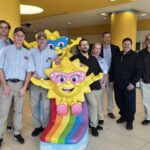An interdisciplinary team of scientists from the University of Miami’s Miller School of Medicine and College of Engineering is poised to begin developing a novel, long-lasting treatment for meniscus tear repair in injured knees.
The Miller School investigators participating in the research project are Thomas Best, M.D., Ph.D., professor of orthopaedics and biomedical engineering, and research director for the University of Miami Sports Medicine Institute, and Michael Baraga, M.D., associate professor of clinical orthopaedics and a member of the Sports Medicine Institute.
 “Meniscal tears are a common problem for which we do not typically have a great long-term solution, as most patients undergoing surgery for a torn meniscus eventually develop osteoarthritis of the knee,” Best said. “Therefore, this work is a great first step towards clinical trials with our patients and our goal of improving short- and long-term function and joint health.”
“Meniscal tears are a common problem for which we do not typically have a great long-term solution, as most patients undergoing surgery for a torn meniscus eventually develop osteoarthritis of the knee,” Best said. “Therefore, this work is a great first step towards clinical trials with our patients and our goal of improving short- and long-term function and joint health.”The knee is one of the largest and most complex joints in the body. Three bones meet to form the knee joint: the thighbone (femur), shinbone (tibia) and the kneecap (patella). Tendons in the knee connect the bones to the leg muscles, allowing movement at the knee joint. Ligaments join the knee bones to provide stability to the knee. Menisci — two C-shaped pieces of cartilage — act as shock absorbers between the femur and tibia.
The complexity of the knee joint components and their intricate relationships make the knee vulnerable to a variety of injuries. Meniscus tears are among the most common type of knee injuries. Athletes, particularly those who play contact sports, are at risk for meniscus tears. However, anyone at any age can tear a meniscus.
“The meniscus is a unique tissue in the body and only has blood vessels supplying its outermost portion,” said Alicia Jackson, an assistant professor in the College of Engineering’s Department of Biomedical Engineering. “The inner part of the meniscus receives its nutrients only by diffusion. Because of the poor blood supply, meniscus tears usually do not heal on their own.”
Meniscus tears are currently treated via total or partial meniscectomy — surgical removal of the meniscus — or suturing. In the long term, these treatments often result in meniscus degeneration, re-tear and premature osteoarthritis — the most common form of arthritis — of the knee.
Funding for the project comes from the National Institute of Arthritis and Musculoskeletal and Skin Diseases. Joining Jackson on the team from the College of Engineering will be Francesco Travascio, Ph.D., assistant professor of industrial engineering, and Fotios Andreopoulos, Ph.D., and Noel Ziebarth, Ph.D., both associate professors of biomedical engineering.
“Our objective is to adopt a computationally assisted bioengineering approach to repair meniscal tear defects,” said Travascio, who will be the team leader. “We will develop a bioengineered scaffold — a composite structure made of synthetic and natural polymers alongside biological compounds that assists in the establishment of biological function and tissue reconstruction — for the knee.”
The bioengineered scaffold will closely mimic the structure, composition, biomechanics, and electro-kinetics of the healthy tissue in the knee to allow it to properly integrate itself into the meniscus and regenerate the tissue at the defect.
“Biomechanical properties of the meniscus, including compressive, tensile, and shear moduli have been thoroughly investigated in the past,” said Jackson. “However, there is relatively little information about the human tissue itself, especially about the structure-function relations. Furthermore, transport and electro-kinetic properties of the meniscus, which are key determinants of cellular behavior, have been scarcely investigated thus far.”
Using their expertise in electro-mechanics, transport, and computational modeling of cartilaginous tissues, the research team will examine the composition, region and structure of each property and develop a novel library of design criteria for the bioengineered scaffold as well as a computation model of the meniscus. Once the scaffold is developed, the team will test the scaffold’s ability to integrate itself into a meniscus and subsequently regenerate the torn tissue.
“The importance of this research lies in developing a long-term solution to a torn meniscus,” said Jackson. “Our novel, computationally assisted, bottom-up approach for a bioengineering tissue construct capable of repairing meniscal tears will pave the way for testing on live animal models and ultimately for clinical applications.”


























